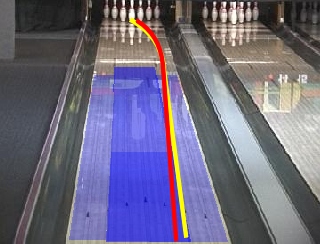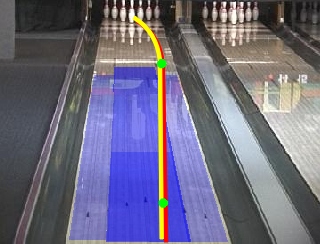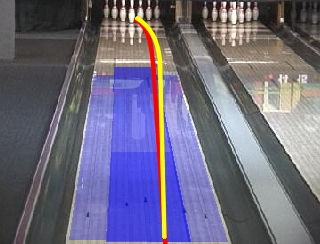Breakpoints and Drawing Lines on the Lane
( Part 3 )
by Ron Clifton
This
is the last of a three part series about how to find your breakpoint on the lane and
how to
use it as part of your targeting system. Part One discussed how to find your
breakpoint and how to train your eyes where to look in order to pick up where your
break point should be. In Part Two we learned to pick a spot at our breakpoint
and draw a line back through our target, continuing back to
where we are going to lay the ball down at the foul line. Part Two also
discussed some of the reasons why I think this type of targeting system is so
important.
It
takes two points to make a line. That is why we use the breakpoint as one point
and a target somewhere much closer to us as the other point. If you only
consider one point, say the 3rd arrow, then that point can be crossed
in any direction. With todayís lane men using the oil pattern to manage scores
up or down, the path your ball takes through the oil can make a huge difference.
Some people may be tempted to just go ahead and look at the breakpoint as their
one and only target. If you are bowling on a typical league shot where you have
a lot of oil between the 10-boards, and your only concern is that you hit the 7-board at the break point, you could get into trouble. Letís say you throw one
ball that crosses the arrows at the 12-board and one ball that crosses the
arrows at the 9-board and both balls nail the 7-board at the breakpoint. Those
two balls will have completely different reactions. The ball that crossed at the
12-board traveled through deeper oil for a longer period of time. The ball that
crossed at the 9-board got out of the deep oil much sooner and hooked much
more. The problem is: if you were only targeting the 7-board at the break point,
you may never know this
information. You will just think that you canít get a consistent reaction.
|
This is a graphic of a typical oil pattern used
in most leagues. The darker the blue, the deeper the oil. The deeper the
oil, the slicker the lane. The red and yellow lines show two different ball
paths. They each hit around the 6-board at the breakpoint, but the red
line goes to the pocket and the yellow one hits too high. If a bowler only
uses the breakpoint as a target, he or she would never know that there were
varying this much at the arrows. The bowler would think he was getting an unpredictable
ball reaction on what looks like two balls that nailed the target.
Actually, the yellow ball leaves the heavy oil and gets into the thin oil
much sooner than the red ball. The yellow ball grips the lane early and
goes high while the red ball hits the pocket. This example can also show
you that it can be dangerous to play too close to the oil line. |

|
|
It takes two points to make a line. A single point can be
crossed in any direction. Here is an example of a bower using a point at
the 7-board, 40 feet down the lane and the 3rd arrow. |

|
|
I see this a lot in league: a bowler uses only the 3rd
arrow as his target; he throws the yellow ball, nails the 3rd arrow and
gets a strike. He then throws the red ball. That shot also nailed the 3rd
arrow, but leaves the 10-pin. The bowler feels he was robbed. Both shots
looked great to the bowler. The truth is, this bowler never paid attention
to his breakpoint. The yellow ball that struck hit the 8-board at the
breakpoint and got outside the river of deep oil (dark blue) that runs
from 10 to 10. This allowed the ball to get a good grip on the lane and
have a good entry angle for the strike. The red ball looked great to the
bowler but it never got outside of 10. The ball traveling through the
heavy oil never had a chance to get a good grip on the lane and had less
angle on the pocket. |

|
In
Part Three, I will mostly focus on the ball from the breakpoint to the head
pin. This is the most critical part of the lane when it comes to throwing
strikes.
We need to carefully watch our ball roll all the way down the lane, but we
really need to pay attention to the ball during the last 20 feet of travel: from
the breakpoint to the head pin. On a freshly stripped and oiled lane, this is
the point on the lane where the ball is no longer skidding through the lane oil
and
is rolling on a dry surface. How our
ball reacts to that surface will determine our strike percentage. Here are a few
things to look for:
If
you throw a hook ball, then you apply axis rotation (side turn) to the ball when
you release it; thatís what makes it hook. Depending on many factors, your
ball will maintain or give up a little axis rotation as it easily skids through
the first 40 feet of a freshly oiled lane. I believe that to have a consistently
high strike percentage, your ball must give up a good amount of axis rotation
between the breakpoint and the head pin. This can be done a little at a time
as the ball approaches the head pin or nearly all at once just before it hits.
Many of todayís balls are so strong, they get to the breakpoint and refuse to
give up any axis rotation. In other words, the ball wants to just keep hooking
and hooking all the way through the pins. This looks great from the settee area
but it will not produce the most strikes. A ball that refuses to give up enough
axis rotation will be hard to control and will tend to cut through the pins
leaving too many 4-pins, 9-pins and 8-pins. I call this giving up of axis
rotation ďburning upĒ. To make an analogy, look at your car; it has a
built-in safety feature called caster. If you turn your wheels to the left (like
the side turn or axis rotation on your ball) and let go of the steering wheel,
your wheels start turning back straight on their own. Your car, just like your
bowling ball, would be harder to control if you let go of the wheel and the car
just kept turning sharply.
We
need to watch our ball closely that last 20 feet to see that it gives up the
right amount of axis rotation. If the ball is too strong on the back end, we need
to change to a weaker ball or a weaker hand position. If the ball is still too
strong on the back end, then you may need to play deeper and cover more boards
to make the ball burn up more.
If
the ball burns up too much it may fail to turn the corner or hit the pins too
weakly leaving 10-pins. Going back to the car analogy, itís like we are making
a sharp turn but let go of the steering wheel too soon. The wheels straighten up
too soon and we donít make the turn.
A
ball that maintains its axis rotation, but fails to make the turn is most likely
skidding; the ball has enough axis rotation to turn the corner, but canít
get enough friction with the lane surface. Going back to the car, it would be
like trying to make a sharp turn on an icy road. You can turn the front wheels
to the left all you want but the car will not make the turn. It will just keep
skidding straight. It is very hard
for some people to tell the difference between a ball that fails to hook because
it is skidding and a ball that is burning up too much. This is especially hard
for people that have a lot of axis tilt. If the ball fails to turn the corner
due to skidding, then you need to slow it down, scuff the ball, go to a stronger
hand position, change your line, or switch to a stronger ball.
Every
time a ball is thrown, it will track some oil into the breakpoint area all the
way through the pin deck. After a few games, you may start to notice your ball is
not hooking as strongly or tends to wiggle the last 20 feet; this is called
carry down. If you are carefully watching your ball roll the last 20 feet, you
will pick up on this and start adjusting sooner. Bowlers who donít pay close
attention to their balls at the breakpoint will waste several shots before they
start to understand what is happening. If you see the ball start to wiggle and
you start leaving 10-pins then the ball is hitting skinny streaks of oil caused
by todayís high flare balls. If you see that start to happen, then you need to
adjust your line slightly to see if you can go around the wiggle spot.
Admittedly,
some of this is for the advanced bowler and I am only scratching the surface
when it comes to ball reaction. But even if this is over your head at this stage
of your game, I suggest you save these coaching tips and reread them as your
game advances.
Bowl
great!
I can be contacted through email at rclifton@triad.rr.com


